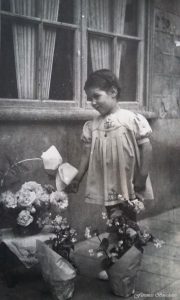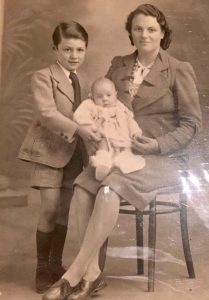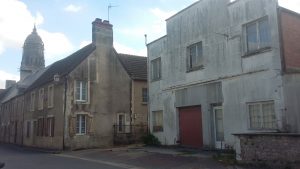This week we are excited to share some excerpts from an interview by Cecile Patrix, mother of Dany Patrix-The Girl Who Wore Freedom, for the 40th Anniversary of the D-Day landings. This piece was originally featured in the LA Times, May 27, 1984, and was originally authored by PAUL DEAN, Times Staff Writer.
This is part 1 of a 2 part series. Don’t forget to check out Part 2.
It was night, yet the glare was midday, and a sky that should have been empty was crowded.
Airplanes were lumped in low formation at 700 feet, and their flares left a phosphorous stink in the damp air. Parachutes jerked open and showed white, green, and red nylon canopies. Engine noises rolled in off the English Channel and boomed deeper until Ste. Marie du Mont and its church and the window of M. Blaizot’s butcher shop began to shake.
 Cecile Patrix stirred and listened. She guessed at an easy explanation. At this hour, over occupied France, it had to be the Luftwaffe and German paratroopers, the Fall-schirmtruppen, on maneuvers again. To think anything else, to think freedom, risked disappointment. Four years of hanging in numbness had given her little reason for hoping, certainly no way of believing.
Cecile Patrix stirred and listened. She guessed at an easy explanation. At this hour, over occupied France, it had to be the Luftwaffe and German paratroopers, the Fall-schirmtruppen, on maneuvers again. To think anything else, to think freedom, risked disappointment. Four years of hanging in numbness had given her little reason for hoping, certainly no way of believing.
Advised to Evacuate
But what was it the BBC had advised in recent programs picked up by the outlawed radio she kept under the bed? French civilians in coastal towns, from Pas de Calais to Brest, should start evacuating their families inland. At least 10 miles.
What had happened 15 days ago? Gestapo teams had toured Ste. Marie du Mont warning residents not to evacuate. A civilian presence, they said, guaranteed that no damage would come to the town.
What of months of Allied bombing of military targets along the French coast? “Rendre facile,” the men had said. Softening up the area.
And what was this excitement her husband, auto mechanic Paul Patrix, was shouting? They’re here. The invasion has begun. “Les Americains, Les Anglais,” he yelped. “Le grand coup.”
The big event in truth.
It was 1 a.m., Tuesday, June 6, 1944. The paratroopers were American and British. They, 5½ hours ahead of amphibious landings along the crescent coastline of Normandy, on Utah, Omaha, Gold, Juno, and Sword beaches, were the scrappy overture to D-Day. And for Axis and Allies, soldiers and civilians, Paul and Cecile Patrix and the 1,000 ordinary citizens of Ste. Marie du Mont, their longest day had begun.
 Cecile Patrix, of course, did what could be expected of any mother.
Cecile Patrix, of course, did what could be expected of any mother.
She dressed the children, Francis, 12, and Danielle, 5, and took them downstairs. She also composed a thought that became a statement of it all, something to carry through 40 years and to a new life in Los Angeles: “We went to sleep as subjects of Germany and awoke as Americans.”
For three hours following those first sights, sounds, and individual realizations that finally could be trusted, there was silence. Eisenhower’s Crusade in Europe seemed stilled. Churchill’s end of the beginning was in apparent suspense.
Pre-Dawn Skies
Then, at 4 a.m., another low-level armada. Camouflage set the C-47s black against pre-dawn skies. They brought more parachutists and were pulling gliders that seemed to be using the village as a reference point for dropping towlines.
Brrrrp-ratatatter. Mon dieux. Machine-gun fire at the gliders and paratroopers. Some of it seemed to be coming from the steeple of the village church.
No matter the shooting, Paul and Cecile Patrix went outside. This would be a sight to see. All of Ste. Marie du Mont seemed to agree. So did German soldiers billeted in the village.
The troops were confused, shouting, cursing. Some carried rifles and all were half dressed beneath unstrapped helmets. A few trotted in the general direction of a narrow strand that, in 2½ hours, would enter history as Utah Beach. Most went the other way. The hesitant were tugged into house-to-house shoot-outs is with straggling, re-forming squads of the 82nd and 101st Airborne divisions.
At 6:30 a.m., the five beaches along a 50-mile front were stormed, men fell in the mined, shelled, bombed, thundering dawn, and three miles inland, in Ste. Marie du Mont, a mother’s elation, turned to horror at first light.
The American paratroopers, the ones the Germans called devils in baggy pants, had been so very young. Twenty, thought Cecile. Nineteen, maybe younger. Just boys. Now so many were dead.
 One had flopped against the doorway of Mlle. Lemonier’s grocery shop. Over there, by the bakery of M. Cardron was another curled up in final sleep. At least they had fought for a while. The American slumped in his parachute harness and dangling from a tree near the town square had died without his boots touching French soil.
One had flopped against the doorway of Mlle. Lemonier’s grocery shop. Over there, by the bakery of M. Cardron was another curled up in final sleep. At least they had fought for a while. The American slumped in his parachute harness and dangling from a tree near the town square had died without his boots touching French soil.
A jeep came into the village. Two Americans, both hefting Thompson submachine guns, pulled up at the garage and bicycle repair shop owned by Paul and Cecile. Could they fix a flat?
Of course. Paul said. But no need to point guns at us, Cecile said. Worry about those three Germans in the church steeple, she said, the ones who have been shooting at descending paratroopers.
A sprint across the square to the church, a kicked door, shouts … and the Germans surrendered without a shot being fired. Two were ordered down from the steeple and forced to lie face down in the street. The third was rooted out of hiding in a confessional.
Join us when we continue with part 2 of this retelling of a real-life story from D-Day.

I’m really enjoying the pats this week! Can’t wait to continue reading…
Thanks, Laura! We thought this gave readers a unique window into the events of D-Day.